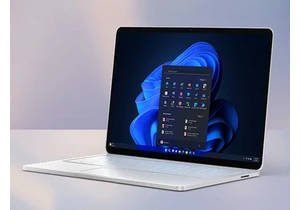Expert's Rating
Pros
- Good everyday 10Gbps performance
- Type-C and Type-A connectors
- Affordable for the capacities
Cons
- The slowest off-cache write speed we’ve ever seen
Our Verdict
For light offloads from your iPhone or other device, the PNY Duo Link V3 performs well, and with both Type-A and Type-C connectors integrated, it can used with most any device. But performance off secondary cache is abysmal, so buy way more capacity than you need.
Price When Reviewed
This value will show the geolocated pricing text for product undefined
Best Pricing Today
<h3 class="review-best-price" id="best-prices-today-pny-duo-link-v3">
Best Prices Today: PNY Duo Link V3 </h3>
<div class="wp-block-price-comparison price-comparison ">
<div id="New" class="new_products_tab tabcontent">
<div class="price-comparison__record price-comparison__record--header">
<div>
<span>Retailer</span>
</div>
<div class="price-comparison__price">
<span>Price</span>
</div>
</div>
<div class="price-comparison__record check_on_amazon">
<div class="price-comparison__image">
<img decoding="async" src="https://www.pcworld.com/wp-content/themes/idg-base-theme/dist/static/img/amazon-logo.svg" alt="amazon" loading="lazy" />
</div>
<div class="price-comparison__price"></div>
<div>
<a class="price-comparison__view-button" href="https://www.amazon.de/s?k=PNY+Duo+Link+V3">Check</a> </div>
</div>
<div class="price-comparison__record price-comparison__record--footer">
<span class="price-comparison__footer-text">
Price comparison from over 24,000 stores worldwide </span>
</div>
</div>
<div id="Refurbished" class="refurbished_products_tab tabcontent">
<div class="refurbished-padding price-comparison__record price-comparison__record--header">
<div>
<span>Product</span>
</div>
<div class="price-comparison__price">
<span>Price</span>
</div>
</div>
<div class="price-comparison__record price-comparison__record--footer">
<span class="price-comparison__footer-text">
Price comparison from Backmarket </span>
</div>
</div>
</div>
<div class="review-software-price">
<div class="software-product-chart-main">
<div class="software-product-chart-pricing">
<div class="product-chart-item__pricing-details">
<div class="software-product-chart-pricing">
<span class="product-chart-item__pricing-details--links-wrapper">
<span class="not-amp">
<div class="software-product-chart-buttons "><div class="item-pricing-details"></div></div> </span>
</span>
</div>
</div>
</div>
</div>
</div>With today’s mix of legacy Type-A and newer Type-C ports, it pays to be able to connect to both. However, adapters have this nasty habit of being misplaced, so a device that has both connector types captive on board, such as the PNY Duo Link V3 reviewed here, can save you a lot of grief.
The caveat here is write performance, which falls off a cliff if you run out of secondary cache. For most scenarios, this won’t come into play, but it did in our testing — so read that section carefully.
Note: If your still leveraging older Apple devices with a Lightning connector — then look to some of PNY’s older Duo Links which are Lighting/Type-A.
What are the PNY Duo Link V3’s features?
First and foremost, the Duo Link V3 is an 10Gbps USB SSD. I get the question all the time: What’s the difference between an SSD and a flash/thumb drive. Form factor — nothing else, though the latter do tend to be a bit light in performance. As SSD stands for solid state storage, and thumb drives have always used NAND, they are legitimately SSDs.
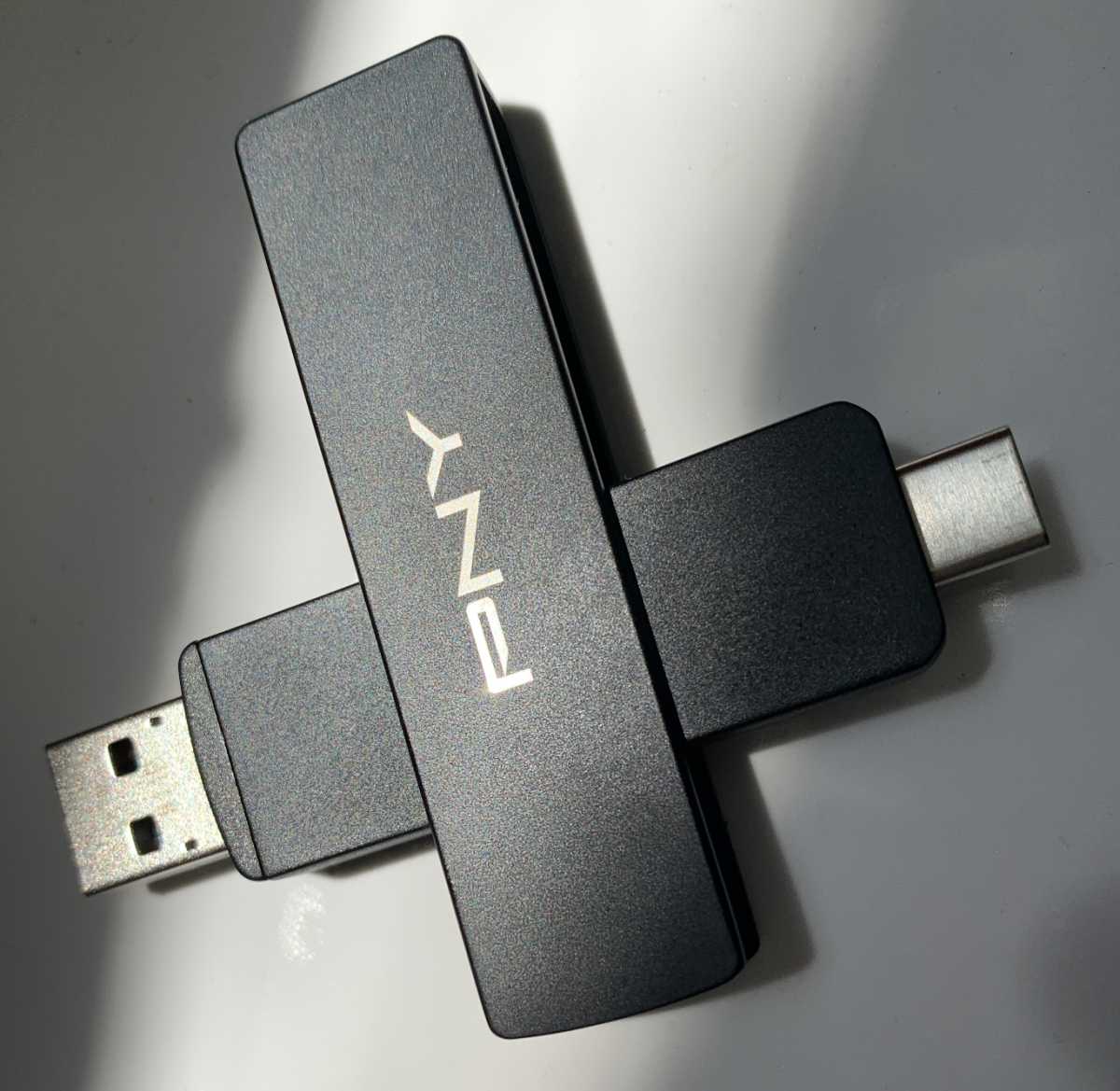
Beyond that, the Duo Link is an approximately 2-inch long black rectangle of an SSD that swivels in a very solid metal sleeve to reveal either its Type-A or Type-C connector (lead image), or both (the above image), if you so desire. There are tiny stops so the drive clicks in place at 180, 360, or 90 degrees.
Weight is a mere 1.5 ounces, though that feels quite solid given the small size. I do have a couple of nits about the design. One or both of the connectors are always exposed, leaving them prey to the elements. Also, the drive fits rather loosely in the shell and I’m not 100 percent optimistic about the long-term prospects of the swivel/stop mechanism.
PNY never clued me in on the type of NAND and controller chip on board, and I was loathe to break out my hammer. Whatever they are, they’re fine for normal duty.
How much does the PNY Duo Link V3 cost?
The Duo Link is available in 256GB/$34, 512GB/$53, 1TB/$86 (tested), and 2TB/$167 capacities. That’s pretty darn affordable for an SSD, or flash drive. But again, read the performance section carefully — you’ll understand at least part of the reason the Duo Link V3 is so cheap.
How fast is the PNY Duo Link V3?
The PNY Duo Link V3 is your normal 10Gbps USB performer reading, and writing — with smaller amounts of data, up to around 240GB with our 1TB test unit.
But if you exceed the amount of secondary cache while writing as we did in the 450GB write, it morphs into the slowest SSD I’ve ever tested — by a lot.
But first, light-duty performance. As you can see below, CrystalDiskMark 8 rated the Duo Link V3’s sequential transfer speed as right in line with the thumb drive competition.
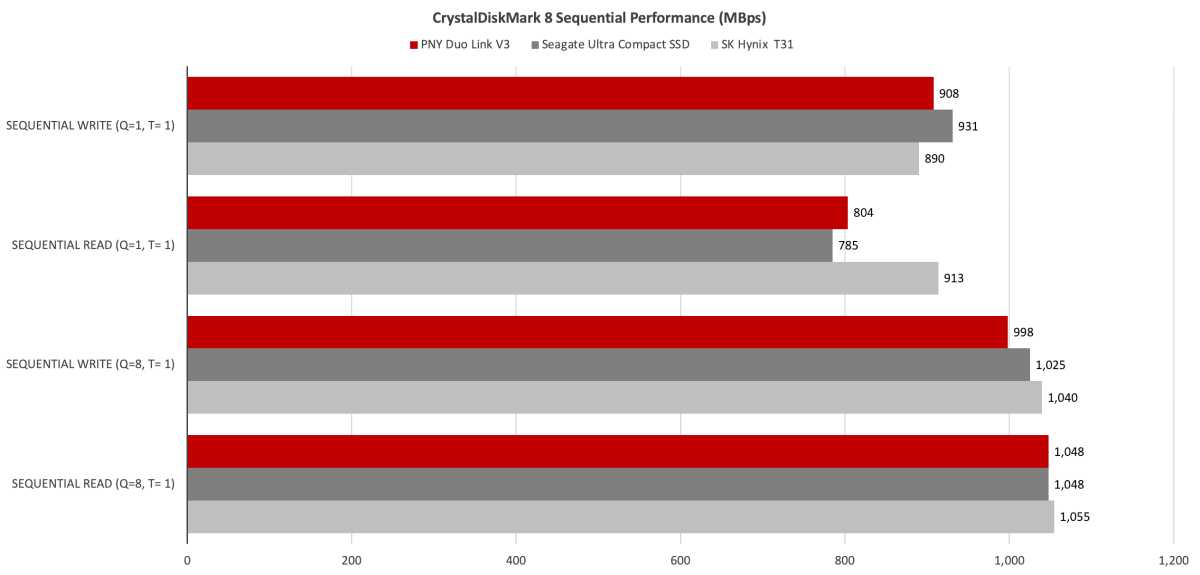
Random performance is also quite sprightly according the CrystalDiskMark 8, cleaning the SK Hynix T31’s clock. By the way, unless stated otherwise, the ATTO and AS SSD benchmarks are roughly in agreement with CrystalDiskMark 8 numbers we post.
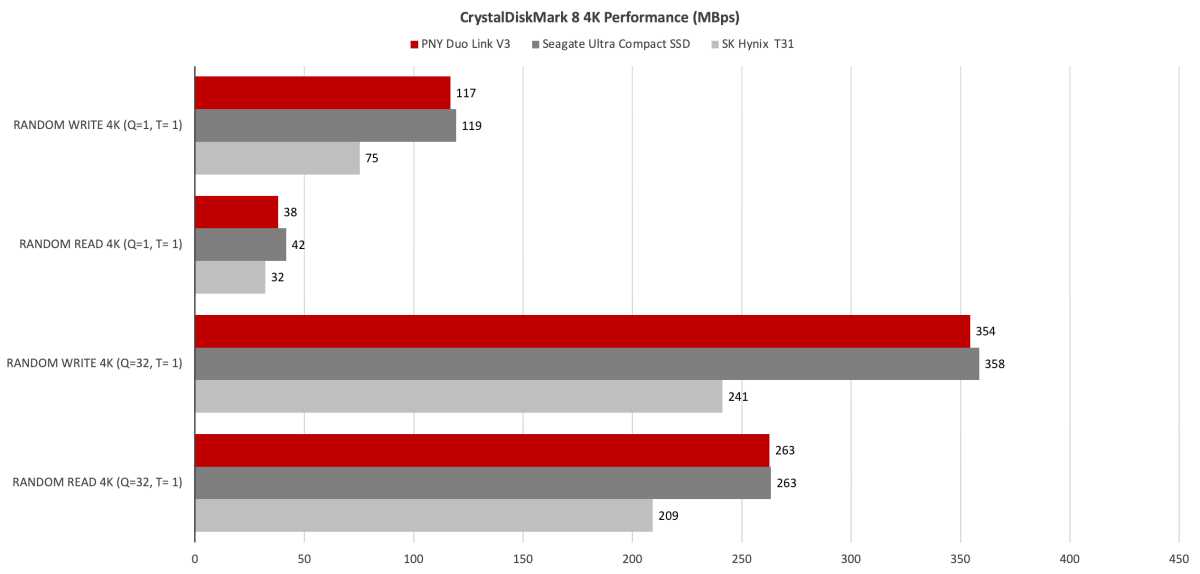
When only transferring 48GB worth of data, the Duo Link V3 was right up there with its competitors on the chart: the Seagate Ultra Compact SSD and SK Hynix T31.
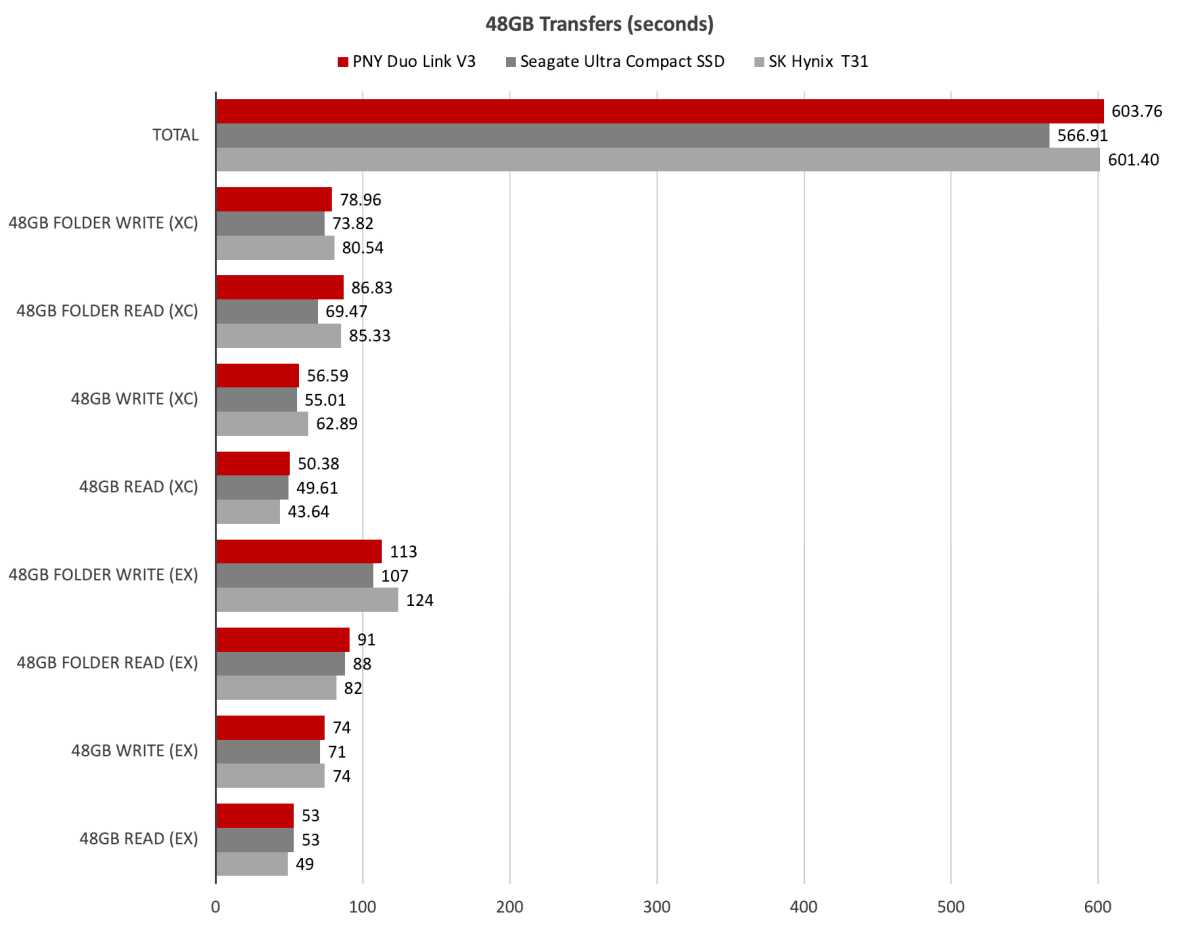
As noted, after secondary cache is exhausted the Duo Link V3 goes south to a degree I’ve never seen before. I spent the better part of the day running the 450GB write tests, the fastest of which was barely under two hours. By way of comparison, the slowest hard drive I’ve tested took only 75 minutes and the previous slowest SSD (another thumb drive), 52 minutes.
Speed started at near 650MBps, then after approximately 250GB had been written, dropped to and vacillated between 15MBps and 100MBps — mostly towards the former. This is remarkably slow for any sort of NAND, even QLC.
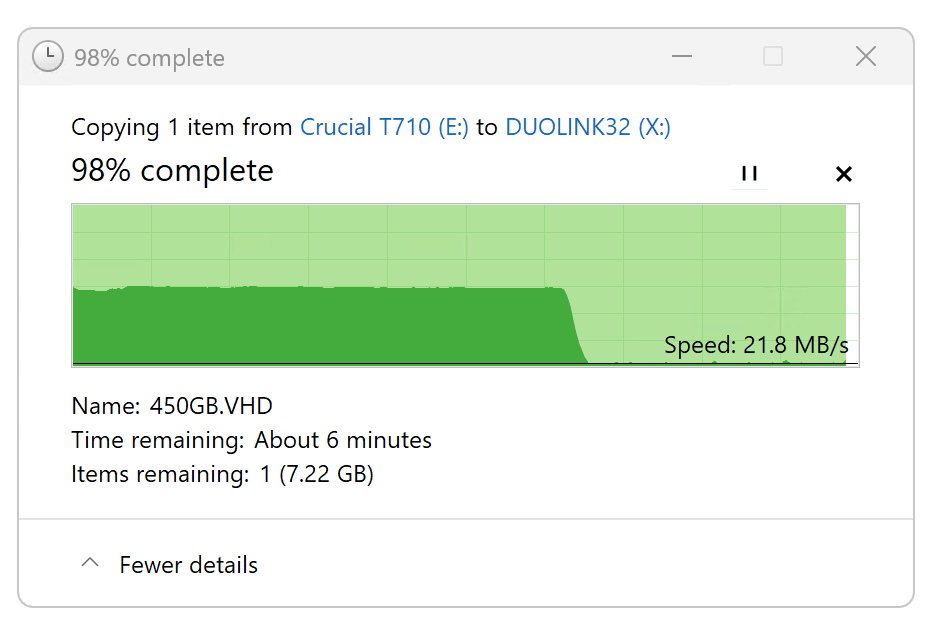
The 450GB write result ruined the drive’s overall rating, but to be fair, the Duo Link V3 is about light-duty convenience, not heavy-duty workloads. I’ll forgive it — and never try to write 450GB to it again.
Note that both the Seagate Ultra Compact and SK Hynix T31 were 2TB, while the PNY Duo Link V3 was only a 1TB drive. Quite likely the 2TB capacity of the Duo Link V3 would’ve turned in a time competitive with the opposition — and tanked right after that.
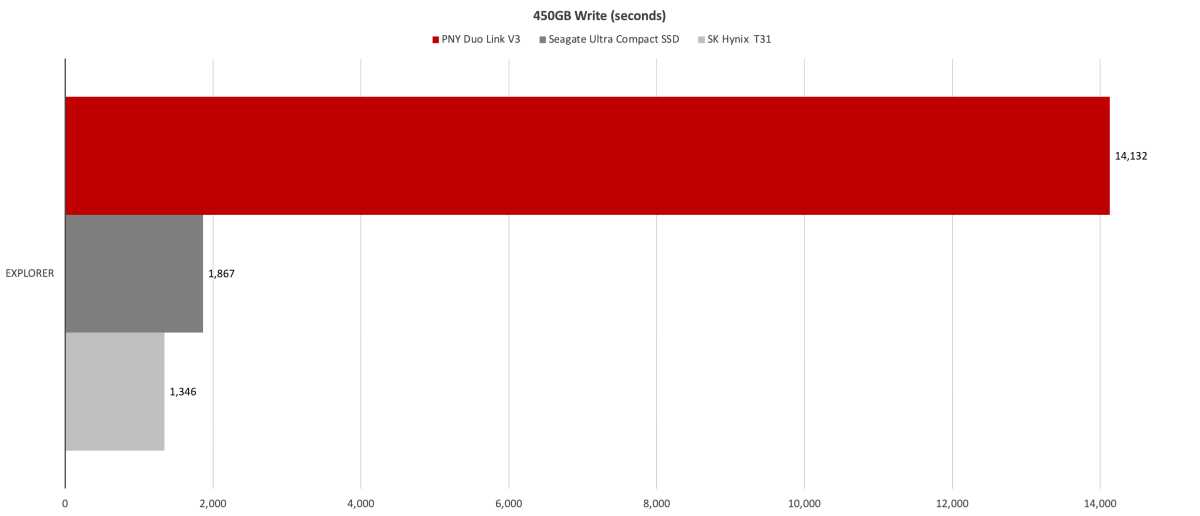
On the plus side, the PNY Duo Link V3 recovered quickly after slowdowns — i.e., subsequent writes would proceed apace after a few minutes of rest. Also, few users will ever write 450GB of contiguous data. We do for the specific purpose of discovering the NAND’s native write rate.
Should you buy the PNY duo link V3?
For most users, the convenience of the Duo Link V3’s dual-connectivity will outweigh possible issues with long writes they may never perform. For light duty, it’s fine.
If, however, you regularly write large amounts of data, say over 25 percent of whatever capacity you buy, then seek another solution.
How we test
Drive tests currently utilize Windows 11 24H2, 64-bit running off of a PCIe 4.0 Samsung 990 Pro in an Asus Z890-Creator WiFi (PCIe 4.0/5.0) motherboard. Th
Login to add comment
Other posts in this group

I’ve wanted a Steam Deck from the first moment I saw one. But I haven

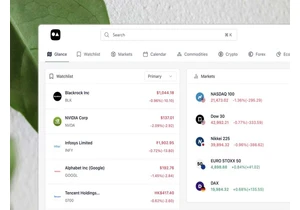

So many people haven’t been able to upgrade their older Windows compu


